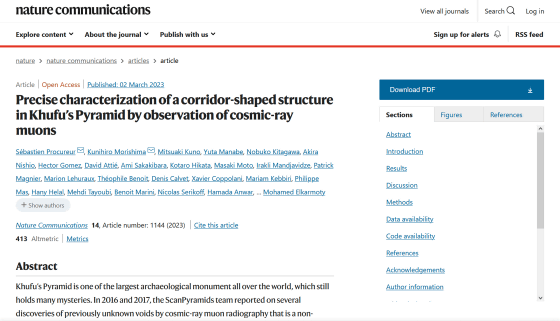Teams such as Nagoya University succeeded in accurately mapping the ``space hidden in the pyramid of King Khufu'' with cosmic rays, and shooting of the internal space with a scope

Precise characterization of a corridor-shaped structure in Khufu's Pyramid by observation of cosmic-ray muons | Nature Communications
http://dx.doi.org/10.1038/s41467-023-36351-0

Hidden corridor in Egypt's Great Pyramid mapped with cosmic rays | New Scientist
https://www.newscientist.com/article/2362300-hidden-corridor-in-egypts-great-pyramid-mapped-with-cosmic-rays/
Scientists have mapped a secret hidden corridor in the Great Pyramid of Giza | Ars Technica
https://arstechnica.com/science/2023/03/scientists-have-mapped-a-secret-hidden-corridor-in-great-pyramid-of-giza/
Cosmic rays reveal 'hidden' 30-foot-long corridor in Egypt's Great Pyramid |
https://www.livescience.com/cosmic-rays-reveal-hidden-30-foot-long-corridor-in-egypts-great-pyramid
ScanPyramids , a project led by the University of Cairo and the French HIP Institute aiming to scan the internal structure of the pyramid, reported in 2016 that there was an unknown space hidden on the north side of the Pyramid of Khufu (PDF file) research results . bottom. And this time, an international research team including Nagoya University and others succeeded in accurately mapping the internal structure of space using muons.
Muons are highly penetrating elementary particles that are formed when cosmic rays collide with the atmosphere. Since they interact differently in low-density gas and high-density solids, muons can be detected to detect objects that cannot be seen from the outside. You can scan the internal structure. By using this method called muon radiography, it is possible to detect hidden spaces that exist in buildings such as pyramids.
The research team used a nuclear emulsion plate and a reading system developed by Nagoya University to record the trajectory of elementary particles in three dimensions, and conducted a survey by placing muon detectors in various places in the passage extending from the north side of the pyramid. As a result, it turned out that there is a horizontal space with a length of about 9m, a width and height of 2m, and a gabled ceiling on the north side of the Pyramid of Khufu. The following pictures are taken of muon detectors placed in various places of the pyramid.

It was also found that the hidden space was so close to the surface of the pyramid that it was possible to shoot directly with a scope, so ScanPyramids was able to insert a scope into the unknown space that was actually discovered and successfully shoot images of the interior. bottom. The state of the internal space taken by ScanPyramids can be confirmed in the following movie.
ScanPyramids SP-NFC 2023 Report from HIP Institute on Vimeo .
A research team trying to insert a scope. It is said that NHK also cooperated with the shooting.

It seems that the space through which the scope passes has been secured in advance with something like a tube, and the scope will enter.

The state of the interior space photographed is as follows. The left, right, and floor are rugged rock surfaces, but the upper part has a beautiful gable shape.

Although the space seems narrow, you can see from the sketches published by the research team that there is enough height for humans to stand. Associate Professor

The secretary-general of Egypt's Supreme Council of Antiquities, Zahi Hawass, said at a news conference on March 2 that the space was likely created to reduce the weight of building materials. Sébastien Procureur, a researcher at the University of Paris-Sacre and co-lead author of the paper, also agrees that the space may have been created as a test for weight-saving structures.
Procureur said about shooting the internal structure, ``I knew there was space, but it's completely different to actually see it.'' ``When we saw this, we felt strange. There seems to be a lot of different opinions, but I think it was good that the space was empty, because I didn't want to participate in opening the tomb.'
Related Posts:







